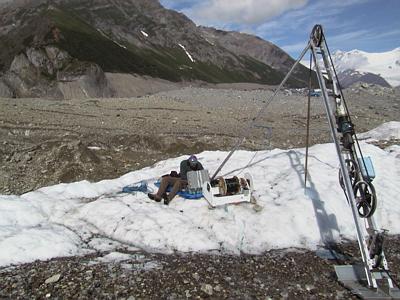7 July, 2000
July 7, 2000
The lake is still rising - about 2-3 feet per day (1-1.5 inches per hour).
It was sunny and warm today. Brilliant weather. There was quite a bit of
run off coming off the glacier. I am sure that there was quite a bit of flow
in Hidden Creek that feeds the lake. The ice continues to make low thudding
sounds. It is still being compressed here.
I spent most of the day looking in the borehole with a video camera. The
borehole camera is a small device about the size of a golf ball that includes
a lens and a ring of red LEDs (light emitting diodes). It connects to a
triaxial cable, the other end of which connects to a digital video camera and
a 12V battery. The battery provides the voltage to power the LEDs. There is
200 meters of triaxial cable between the lens/LED system (which I will refer
to as the camera) and the video. The camera is lowered into the hole, and
the image can be viewed and recorded into the video camera.
As I mentioned in previous journal entries, we think that there is some kind
of a drainage feature in our boreholes at a depth of about 115-120 meters.
So, our interest is to try to observe this feature and if present, attempt to
detect if there is any water flow in the feature. When we lowered the camera
we observed a dramatic change in the quality of the water in the hole at 121
meters - it changed from cloudy to clear. This implied that the suspended
fine-grained sediment from the upper portion of the borehole was being
"siphoned off". We pulled out the camera and attached a string at the end of
it, re-lowered the camera, and looked for any motion of the string. Sure
enough, there was a slight bit of movement. We had observed a small amount
of water flow englacially (water moving inside the glacier at a relatively
deep spot).
I would like to add that I have a fellow teacher colleague beginning a
similar project here in Alaska a few hundred miles away on the Matanuska
glacier. His name is Marvin Geesting and I encourage you to check out his
journal entries as well. You will likely see that his project has
similarities, and also some differences. In his project, die tracers will be
lowered into moulins (drainage holes in the ice). Observations will be made
as to where these tracers reappear, samples will be taken, and their change
in concentration with time will be measured. This will help them understand
the geometry and flow characteristics of the subglacial hydrology. We would
like to do the same thing. However, in our case we will not be releasing
dyes. Releasing dyes to Hidden Creek Lake to trace its flow patterns as it
drains presents a tactical obstacle. The lake would dilute the dye too much.
Adding enough dye to overcome this problem is prohibitively expensive.
Further, we are in a national park. Adding synthetic tracers to the lake and
watching them emerge from the glacier at McCarthy might not go over very well
with park visitors.
However, PI (Principal Investigator) Suzanne Anderson is a water chemist.
She teaches at U.C. Santa Cruz. She is involved with this project to look
for natural tracers that will show a connection between the water in Hidden
Creek Lake and the discharge water during the flood. They sampled water from
Hidden Creek (the stream that feeds into Hidden Creek Lake), from Hidden
Creek Lake, and have been taking numerous samples at regular intervals from
the Kennicott River where it emerges from the glacier. All of these samples
will be analyzed for a number of chemical parameters to look for any
relationship between the waters of Hidden Creek Lake and the outburst flood
waters.

Here I am working the borehole video camera equipment. The spool of cable is being lowered into a 150 meter-deep hole in the glacier. A camera lens that is ringed with LEDs at the end of the cable is transmitting images back to the surface where I am able to view them on a hand-held video camera. Notable features are then recorded onto the video camera.

Contact the TEA in the field at
.
If you cannot connect through your browser, copy the
TEA's e-mail address in the "To:" line of
your favorite e-mail package.
|
